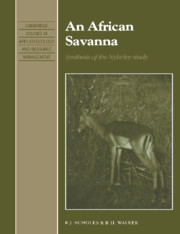10 - Primary production
Published online by Cambridge University Press: 06 October 2009
Summary
One of the first unifying ideas in ecosystem theory was that an ecosystem could be characterised by describing the path and pattern of energy flow through it (Lindeman 1942). By reducing all the interactions within an ecosystem to the common currency of energy exchange it became possible to make comparisons within and between ecosystems. Energy transfers are difficult to quantify directly. Carbon flows came to be a surrogate measurement for energy, since most of the useful energy in an ecosystem is transferred as chemical energy stored in carbohydrates. Carbon assimilation by plants through the process of photosynthesis is an especially important ecosystem parameter, since it places a limit on the amount of energy available to sustain the entire ecosystem. It is conventionally expressed in terms of dry matter produced by plants per unit area over a given period of time (g DM m–2 y–1), and referred to as primary production. The measurement of primary production was a key element of the International Biological Programme, which strongly influenced the initial work at Nylsvley.
The accurate and complete measurement of primary production is an extremely onerous task. When the labours of several scientists for several years are required to produce a single number, with disappointingly large confidence limits and doubtful generality, disillusionment inevitably sets in.
- Type
- Chapter
- Information
- An African SavannaSynthesis of the Nylsvley Study, pp. 144 - 167Publisher: Cambridge University PressPrint publication year: 1993
- 2
- Cited by



